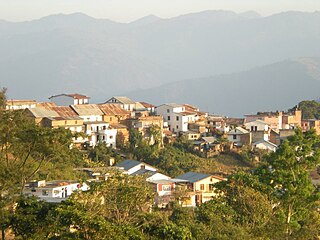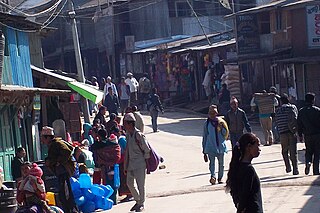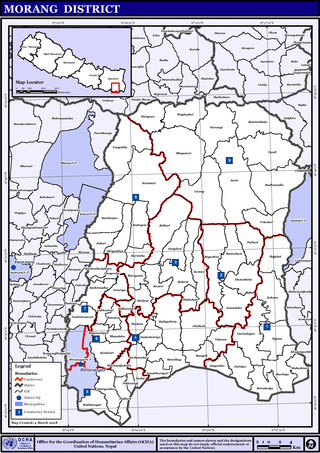
Dhankuta is a hill town and the headquarter of Koshi Zone located in Dhankuta District of Eastern Nepal. According to 2011 Nepal census, it has population of 26,440 inhabitants.

Bhojpur is one of two urban municipalities in Bhojpur District of Province No. 1 of Nepal. It was established on 18 May 2014 merging the existing Bhaisipankha, Bokhim, Bhojpur, Taksar Village Development Committees It is the district headquarters of Bhojpur District, a hilly/mountainous district in Province No. 1. At the time of the 2011 Nepal census it had a population of 27204 with an area of 159.51 square kilometres (61.59 sq mi).

Dhankuta District is one of 14 districts of Province No. 1 of eastern Nepal. The district covers an area of 891 km2 (344 sq mi) and has a population (2011) of 163,412. Dhankuta is the district headquarters of Dhankuta District.
Yakkha is a language spoken in parts of Nepal, Darjeeling district and Sikkim. The Yakkha-speaking villages are located to the East of the Arun river, in the southern part of the Sankhuwasabha district and in the northern part of the Dhankuta district of Nepal. About 14,000 people still speak the language, out of 17,003 ethnic Yakkha in Nepal. Genealogically, Yakkha belongs to the Eastern Kiranti languages and is in one subgroup with several Limbu languages, e.g. Belhare, Athpare, Chintang and Chulung. Ethnically however, the Yakkha people perceive themselves as distinct from the other Kiranti groups such as Limbu.

Myanglung is a municipality and the district headquarters of Terhathum District of Province No. 1 in eastern Nepal. The municipality is situated at an elevation of about 1500 metres above sea level. Myanglung was converted into a municipality from a village development committee on 18 May 2014, merging the existing village development committees of Myanglung, Piple, Jirikhimti, Ambung, Sabla and Tamphula. According to the census of 2011 the total population of Myanglung is 19,659 including five VDCs.

Tokha Chandeshwari is a village and former Village Development Committee that is now part of Tokha Municipality in Kathmandu District in Province No. 3 of central Nepal. At the time of the 2011 Nepal census it had a population of 3961. Tokha Chandeshwari now is part of Tokha municipality.

Lalbandi is a Municipality in Sarlahi District in the Janakpur Zone of south-eastern Nepal. The municipality was established on 18 May 2014 by merging the existing Parwanipur VDC, Netragung vdc, Jabdi, Lalbandi and Pattharkot VDCs. At the time of the 2011 Nepal Census it had a population of 59,395 people living in 3295 individual households.There are 17 wards in this municipality.It is the largest municipality in Sarlahi district.The office of this municipality is in ward no.6 Located in the Lalbandi.Lalbandi Bazar, located on the East West Mahendra highway, is one of the main trading areas within the municipal area.Bordering East Ishwarpur Municipality, West Hariwan and Haripur Municipality, North Sindhuli District and bordering Haripur and Ishwarpur in the south, Lalbandi Bazar is the main trading site of the district.

Phakchamara is a village development committee in the Himalayas of Terhathum District in the Kosi Zone of eastern Nepal. At the time of the 1991 Nepal census it had a population of 3041.. Brahmin, Chhetri, and Limbu are the main cast of this VDC. Naween Shikshya Sadan Higher Secondary School is the oldest School of this region as well as of this VDC. Several philanthropists contribute to the educational development of this VDC through this school. Mr. Krishna Prasad Dahal was a long time "Head sir" of this school and significantly contributed to the local society for uplifting the educational levels of numerous people of this region. "Dahal" and "Niroula" families contributions are tremendous for the development of this region and of this VDC. Currently, under new reformation of the political system in Nepal, it is included within "Chhathar VDC Ward No. 4". The Chhathar VDC chair after the election on 2017 is Santosh Tigela from Communist Party of Nepal. The only road that connects this region to Teria and accessible municipalities like Dhankuta and Dharan is by "Sindhuwa Sukrabare Road". The construction of this 8 km road has been started in 1986 but not pitched and completed yet due to corruption and idiot leaders. "Sukrabare bazaar" is the major business hub of this region. Buses and private vehicles are now run in this road 12 months after the graveling of the road in 2019. This is beautiful VDC with a pristine panorama of "KumbhaKarna Mountain" and a silver lining shine of Tamor River. Rhododendroen is everywhere mostly in the higher region. Water crises, foreign employment are the major problems. The Upper regions which are mostly wetland should be protected and initiate aforestation for the future of this VDC.

Bhedetar is a village development committee in Dhankuta District in the Koshi Zone of eastern Nepal. At the time of the 1991 Nepal census it had a population of 2643 people living in 513 individual households. It is 1,420 meters high from the sea level. It is actually the border line of Sunsari and Dhankuta district.

Pakhribas is an urban municipality out of three urban municipalities located in Dhankuta District of Province No. 1 of Nepal. Pakhribas municipality established on 2 December 2014 merging following VDCs: Pakhribas, Sanne, Phalate, Ghortikharka and Muga.

Chandrapur Municipality other names Chandranigahapur locally known as Chapur is a Municipality in Rautahat District in the Narayani Zone in Province No. 2 of southern Nepal. The municipality was established on 18 May 2014 by merging Chandranigahapur, Judibela, Paurai, Santpur Matioun, Dumariya Matioun VDCs.

Letang, "लेटाङ " is a Municipality in Morang District in the Province No. 1 of south-eastern Nepal. It was formed by merging the existing Village Development Committees of Letang, Janta, Warrangi and Bhogateni.

Rajghat is a small village in the Urlabari Municipality, comprises two wards; 8 and 9 in the Morang District in the Koshi Zone of south-eastern Nepal. It is located in North-East part of Morang and 1.5 kilometers south of the East West national highway of Nepal. Durgapuri Bazar is the central emerging town of Rajghat.
Kurule Tenupa is a village Development Committee of Dhankuta District in Nepal. It is far from the headquarter of Dhankuta District. Dhankuta is linked with Kurule Tenupa via road. It takes about six hours to reach Kurule Tenupa from Dhankuta. In the past, this village was not so much developed but now the living standard of people is high. Most of the people here depend on Agriculture. Young men are going for foreign employment which has increased the inflow of money. But the miserable situation of this village can be seen when there will be scarcity of water. Due to lack of water resources, people living here are migrating to Terai areas like Urlabari, Damak, and other plain areas of Eastern Nepal.

Province No. 1 is the easternmost of the seven provinces established by the new constitution of Nepal which was adopted on 20 September 2015. With the industrial city of Biratnagar as its headquarter, the province covers other major eastern towns including Damak, Dharan, Itahari, Inarua and Birtamod and includes several mountains including the Everest, Kanchenjunga, and Ama Dablam. Koshi - the largest river of the nation, circumvents the province's western boundary. Adhering to the first-past-the-post voting system issued by the Constituency Delimitation Commission, the province hosts 28 parliamentary seats and 56 provincial seats.

Sangurigadhi is a rural municipality (gaunpalika) out of four rural municipality located in Dhankuta District of Province No. 1 of Nepal. There are a total of 7 municipalities in Dhankuta in which 3 are urban and 4 are rural.

Chaubise is a rural municipality (gaunpalika) out of four rural municipality located in Dhankuta District of Province No. 1 of Nepal. There are a total of 7 municipalities in Dhankuta in which 3 are urban and 4 are rural.

Khalsa Chhintang Sahidbhumi is a rural municipality (gaunpalika) out of four rural municipality located in Dhankuta District of Province No. 1 of Nepal. There are a total of 7 municipalities in Dhankuta in which 3 are urban and 4 are rural.

Chhathar Jorpati is a rural municipality (gaunpalika) out of four rural municipality located in Dhankuta District of Province No. 1 of Nepal. There are a total of 7 municipalities in Dhankuta in which 3 are urban and 4 are rural.













